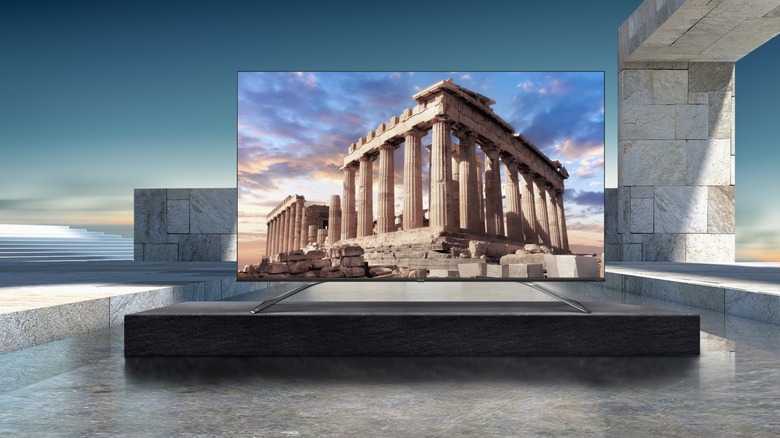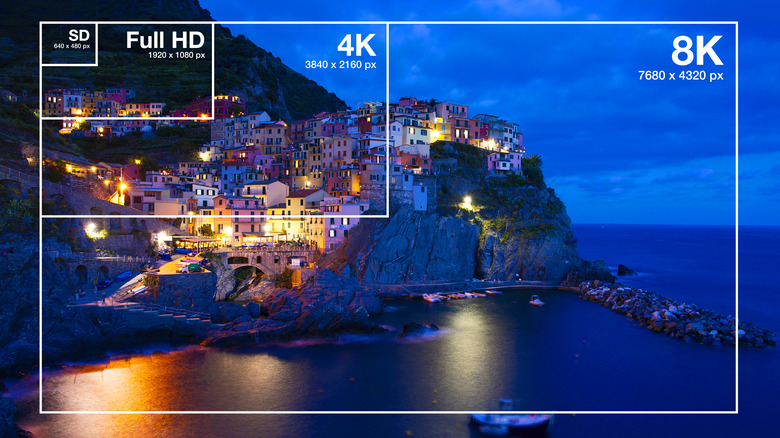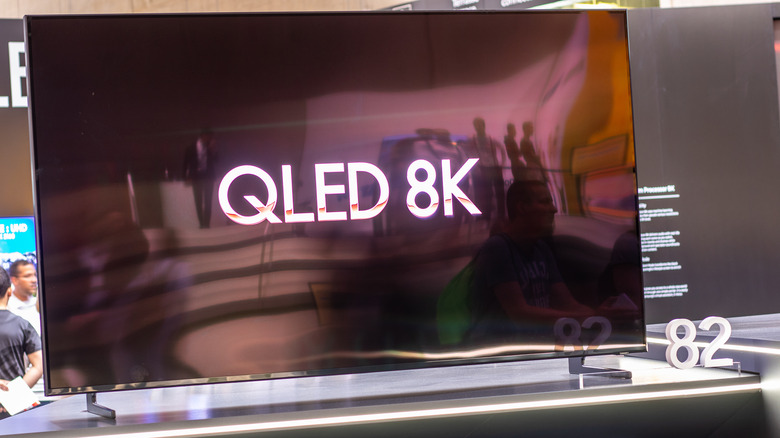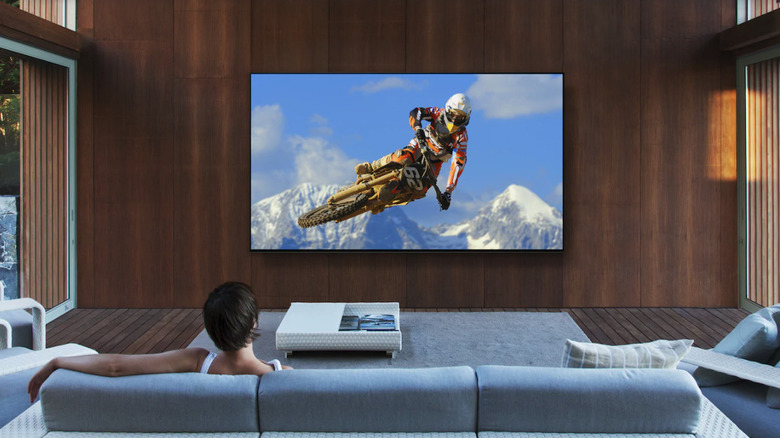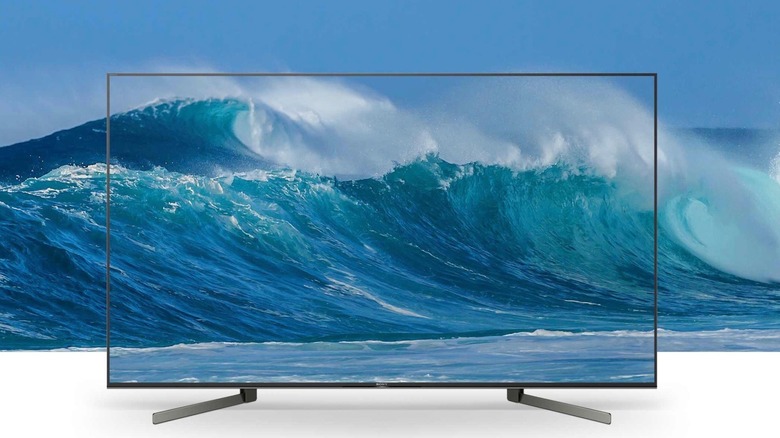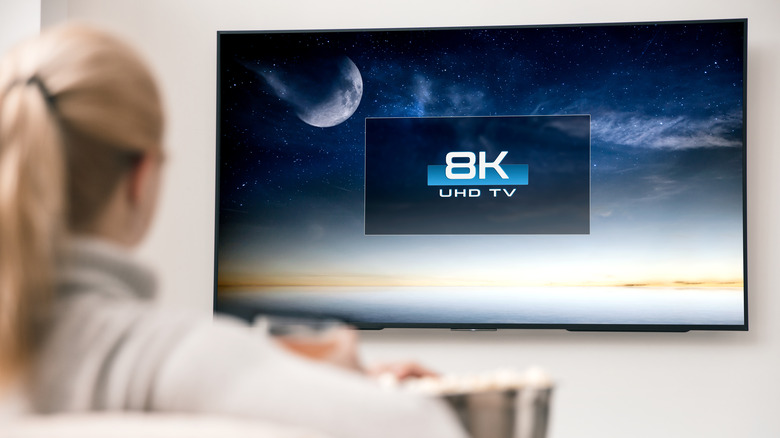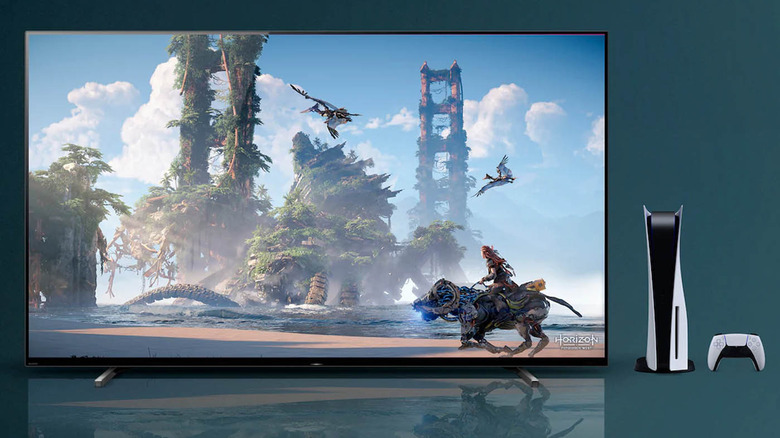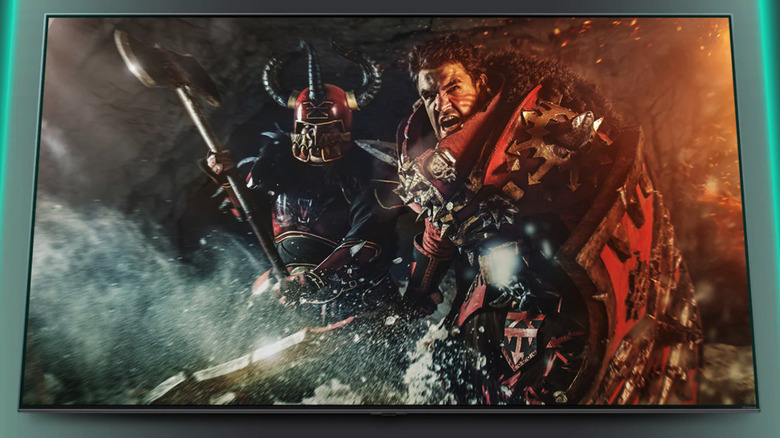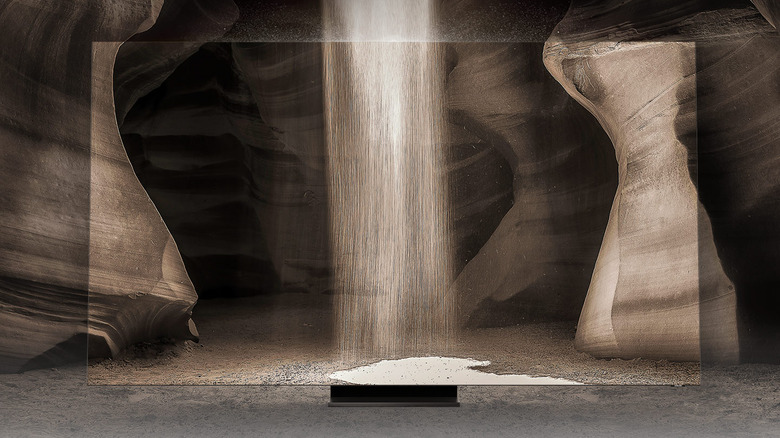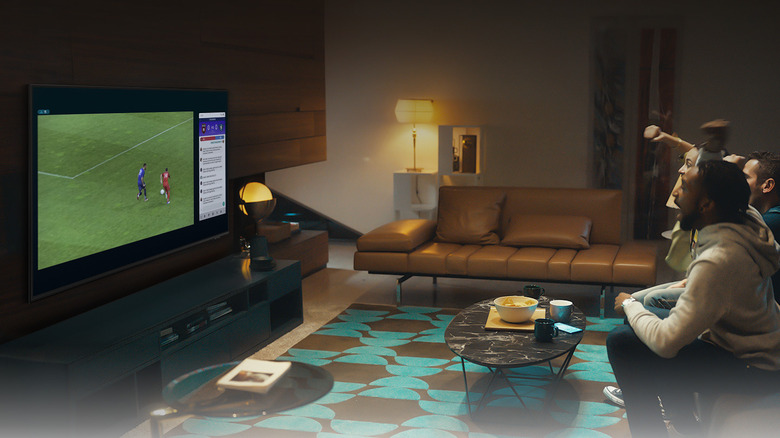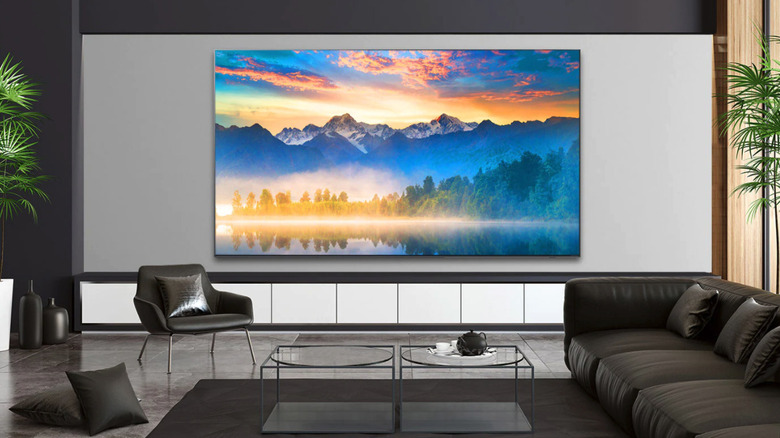8 Reasons You Shouldn't Buy An 8K TV Yet
We may receive a commission on purchases made from links.
A full decade has passed since the first 8K displays were showcased at CES 2012. While the much-ballyhooed TV tech continues to gain momentum slowly, it's still far from taking over as the TV tech standard. Several manufacturers have 8K sets on the market, including Samsung, Sony, LG, TCL, and Hisense, with Panasonic and Philips coming soon. But for now, the TV-makers have the most to gain from pushing 8K; while the displays boast of big pixel numbers, they also require a big investment and suffer from an even bigger lack of 8K content.
The now-old "Full HD" standard of 1080p has a 1,920 x 1,080 pixel resolution, which the new favorite 4K TV quadruples with 3,840 x 2,160 pixels. Now, 8K has quadrupled 4K — its 7,680 x 4,320 pixel resolution equals 16 times that of 1080p. But there are still plenty of reasons why you might want to hold off buying an 8K TV, at least for now.
What are 8K TVs exactly?
Influential trade group the Consumer Technology Association (CTA), which runs the annual Consumer Electronics Show (CES), established a definition in late 2019 for what constitutes an 8K Ultra HD display. In addition to the minimum of 33 million active pixels from the 7,680 x 4,320 resolution within a 16:9 viewable window, an 8K Ultra HD display must also include at least one HDMI input that supports 8K resolution at a bit depth of 10-bits, a frame rate of 60fps, and HDR (high dynamic range). Essentially that means the TV must have at least one HDMI 2.1 input (or the new HDMI 2.1a updated input). Finally, an 8K Ultra HD display must be able to upscale SD, HD, and 4K video to 8K UHD resolution.
Those minimum specs look pretty good, but aside from the resolution, they are all things that you can find in good mid-price-range 4K TVs, like the Sony X90J. And because of the human perception of 8K resolution on most TV-sized screens, the big pixel numbers don't necessarily mean you should spend big dollars for an 8K TV.
The price is too dang high
Scanning the prices at retailers such as Best Buy for 8K TVs versus 4K TVs shows you that the 8K versions of a manufacturer's line cost roughly twice that of the 4K versions. For example, the top-of-the-line Samsung 85-inch Neo QLED 8K TV costs $6,499, while the top Samsung 85-inch Neo QLED 4K TV costs $3,299. You can save money by going with a different brand at a smaller screen size, but the price ratio is still roughly the same. For example, the 8K version of the 75-inch TCL 6-Series TV costs $2,699, while the 4K version of the 75-inch 6-Series costs $1,299.
You can go to different retailers, shop different brands, and compare different series of televisions from those brands, but the results stay fairly consistent. 8K TVs currently cost about twice the price of their 4K siblings.
While tech-savvy consumers understand that the latest and greatest examples of a particular appliance or gadget come at a premium, they also expect that higher cost to come with an elevated experience commensurate with the elevated price. That, however, is not exactly the case with 8K TVs.
Incremental increase in image quality
While 8K is four times the pixel count of 4K, it certainly doesn't look four times better to the human eye. In fact, according to the 2020 double-blind study "Tested Perceptual Difference Between UHD-1/4K and UHD-2/8K" from Warner Bros., the American Society of Cinematographers (ASC), Amazon, LG, and Pixar, 8K video increases the perceived picture quality over 4K only minimally.
For the study, more than 100 people watched live-action and animated clips created in native 8K and the same clips downscaled to 4K on an LG 88-inch OLED 8K TV. The viewers' most common response was that the 4K and 8K clips looked the same, while the second most common response said that the 8K clips looked somewhat better, and a small number of responses claimed the 4K clips looked better. The average of all the responses judged that the 8K clips looked "marginally slightly better" than the 4K versions. And people with better than 20/20 vision sitting five feet from the TV (as opposed to sitting nine feet away) scored the 8K clips just a small degree better than the remainder of the group.
These survey results hammer home the point that despite having four times the pixel resolution of 4K displays, 8K TVs only look slightly better to some people and basically the same as 4K TVs to many people. And to notice the difference, it helps to have a large TV and to sit closer to the screen than the average of seven feet away.
It's hard to see the improvement
Why should people not have a better appreciation for the prodigious pixel count of 8K TVs? After all, digital and film imaging expert Dr. Roger Clark conservatively estimated that a hypothetical screen that encompassed the human field of vision would be 576 megapixels in size. 8K resolution has 33.17 megapixels.
However, as Clark pointed out, the human eye does not capture images like a camera taking a snapshot. Only a tiny part of the eye, the fovea centralis — a small area about 0.3 mm in diameter and highly concentrated with photoreceptive cones — actually perceives with the maximum possible visual acuity. Your brain creates a pastiche for the rest of your field of visual perception from the eyes' saccades — involuntary and very fast twitch-like movements — and from the visual memory of what you have seen around you.
So while the difference between 8K and 4K TVs is perceptible under the right conditions, the benefits of 8K video concentrate more on the production side for shooting in 8K and zooming in on smaller areas that will still have at least 4K resolution. Just as well, 8K has benefits for extremely large screens or projected images that most people will not experience in their homes unless it's under the guise of virtual reality (and in the case of VR, 8K will not be practical from a computational perspective in the short-term).
Where's the content?
It's still hard to find a lot of 8K video to watch on an 8K TV. The major streaming services like Netflix, Amazon Prime Video, and Apple TV+ don't have native 8K content yet. The most common destinations for 8K content are YouTube and Vimeo, but even there, not many of the content creators are uploading native 8K video yet.
It's hard to blame any YouTube content creators for not producing 8K videos when the prices of the well-regarded Red 8K professional cameras range from $24,000 to $50,000 for just the camera body. Besides that, not every video editing software can even import 8K video yet.
So the mantle of native 8K content will have to be carried by professional production companies, and for the most part they haven't picked it up yet, whether it's for TV, films, or video games. None of the household name streaming services like HBO Max or Disney+ have announced forthcoming support for 8K material, and 8K video games are scarce, to say the least.
Game consoles aren't ready yet
The Sony Playstation 5 and Xbox Series X consoles both claim to handle 4K gaming at 120 FPS as long as the game and display are compatible with those specs. However, even high-end PC gaming GPUs strain to deliver 4K at a steady 120 FPS for current big-budget AAA games. So while the PS5 and Xbox Series X will both be able to output 8K at 60Hz upon a future update, their hardware is dubious for actually presenting native 8K at the maximum 60FPS rate. Performance may be more tenable should there be mid-generation console upgrades with hardware bumps, such as PS5 Pro following in the footsteps of the PS4 Pro that enabled 4K gaming.
Regardless, for consoles and PCs to fully utilize 8K output in games, the games themselves will have to be produced for native 8K output, and game developers are still catching up to the 4K format. Few games are available that were produced in 8K, and the 8K console games that do exist can't be played in 8K yet anyway, until Sony and Microsoft upgrade their firmware. For the foreseeable future, console games are much more likely to be made for 4K, which the console or an 8K TV itself can upconvert for 8K viewing.
Many first-hand reports on upscaling 4K content to 8K relate that even with very good processing technology at work, upscaling from 4K to 8K falls short of the experience of native 8K material.
Frame rates are more important than 8K resolution
If most 8K output from next-gen game consoles is actually going to be upscaled 4K resolution, then the more effective technology for your TV to have is a 120Hz refresh rate (120 frames per second) and variable refresh rate (VRR). A 4K TV with a 120Hz refresh rate will be able to accept the highest frame rate from next-gen game consoles. The previous generation consoles, as well as many current 4K TVs, are limited to 60 FPS, but the higher 120 FPS capability allows fast-action motion to appear natural and smooth. Additionally, if your TV also has VRR, it will automatically adapt its refresh rate to match what the game console sends it, greatly reducing the chances for image tear artifacts, which can result from locked constant refresh rates.
Both 120 FPS and VRR are unlocked with the HDMI 2.1 spec, but not every TV with HDMI 2.1 will automatically have 120 FPS and VRR, so check on that to be sure.
There are other TV performance considerations that can also make a bigger difference than going from 4K to 8K resolution. A TV's contrast ratio and black levels, color gamut, level of HDR technology, and brightness of the HDR all help determine the picture quality of the available pixels, rather than simply adding more pixels.
It's worth it to wait
Right now, 8K TV are still in the overpriced phase where 4K TVs also were when they first came out. Within a manufacturer's series of TVs, the 8K version can easily cost twice as much as the 4K version of the same series. However, the same can't be said for the price of 4K TVs over 1080p TVs, because the price of 4K TVs has come down and is continuing to go down. It will likely still be a couple of years at least before we see the price of 8K TVs drop closer to that of current 4K TVs.
Besides that, there is very little 8K content available now, and if 8K material ever becomes the norm, the current 8K TVs may not even play the future 8K material if technical standards fluctuate the way they did with 4K content. So for both price and content reasons, it's worth it to practice a wait-and-see approach toward 8K TVs.
Too much bandwidth to stream video content in 8K
There's more to figuring out the bandwidth required for 8K video than just its resolution. Unfortunately, YouTube, one of the main destinations for viewing 8K video right now, does not yet have a recommended sustained internet speed for watching 8K content.
Estimates for how much download bandwidth speed you'd need to stream 8K go all the way to 100 Mbps, which is quadruple the recommended rate for 4K. However, in the end, 8K streaming should ultimately be adequate with a lower bandwidth than quadruple the rate of 4K. Other factors like the refresh rate of the video and the efficiency of emerging video codecs also play a role in bandwidth, and can even reduce the amount needed. Many experts seem to have agreed on a 40-50Mbps range of internet download speed to stream 8K, which still presents a challenge for many viewers' ISP speeds or data limits.
The final word on why you shouldn't buy an 8K TV yet
Given a large enough screen size — a minimum of 65 inches and preferably more — 8K TVs do present a moderate increase in the perceived picture quality, but with the current high 8K TV prices, you'd be better off buying a well-outfitted 4K TV that includes HDMI 2.1, 120Hz refresh rate, and variable refresh rate (VRR) capability.
There is also very little native 8K material available as video or game content, so you'd be watching a lot of stuff upscaled from 4K or even from 1080p. More 8K content will come as 8K camera and other 8K infrastructure prices fall, and/or consumer demand for 8K content rises. Yet that demand will not skyrocket while 8K TVs are priced as high as they are, and so we face the classic chicken-or-egg dilemma when it comes to consumer demand for 8K TVs and 8K content creation.
The only super-invested parties in 8K TV at the moment are the TV manufacturers, and you owe them nothing. You don't need to be the overcharged catalyst for eventual 8K mainstream adoption. If you're feeling the urge to upgrade your TV in 2022, you'd do well to find the best 4K model you're willing to buy, including the high-end tech like an OLED display, 120Hz refresh rate, HDMI 2.1, and VRR.
